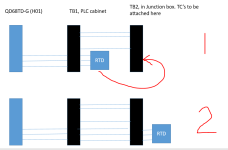A type K thermocouple is not suitable to measure those low temperatures, you should use a PT100 RTD probe that is much more accurate for that temperature range and of course change the Mitsubishi module for another for RTD probes
Type K thermocouple is suitable for temperatures above 500-600ºC up to 1100-1200ºC
Type K thermocouple is suitable for temperatures above 500-600ºC up to 1100-1200ºC





